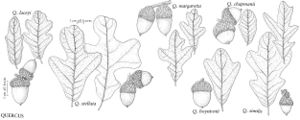Quercus similis
J. Elisha Mitchell Sci. Soc. 40: 43. 1924.
Trees, deciduous, to 25 m, with single straight trunk. Bark brown, scaly. Twigs grayish, 2-3 mm diam., persistently tomentulose. Buds brown, ovoid, 2-3 mm, apex acute or rounded, proximally pubescent. Leaves: petiole 3-10 mm. Leaf blade obovate or narrowly obovate, (50-)75-120(-150) × 50-65(-80) mm, base rounded-attenuate or acute, margins flat, shallowly 2-3-lobed on each side, lobes usually simple, oblong or rounded, rarely spatulate, not cruciform, secondary veins 3-5 on each side, apex broadly ovate or acute; surfaces abaxially grayish, sparsely glandular and sparsely appressed-stellate, adaxially dark green, glossy, sparsely stellate. Acorns 1-3, subsessile; cup 6-7 mm deep × 10-13 mm wide, scales closely appressed, grayish, finely tomentulose; nut light brown or dark reddish brown, ovoid or oblong, 12-16 × 8-12 mm, puberulent or glabrate. Cotyledons distinct.
Phenology: Flowering spring.
Habitat: Forests in wet stream bottoms, flatwoods, river valleys
Elevation: 0-300 m
Distribution

Ala., Ark., Ga., La., Miss., S.C., Tex.
Discussion
Selected References
None.
